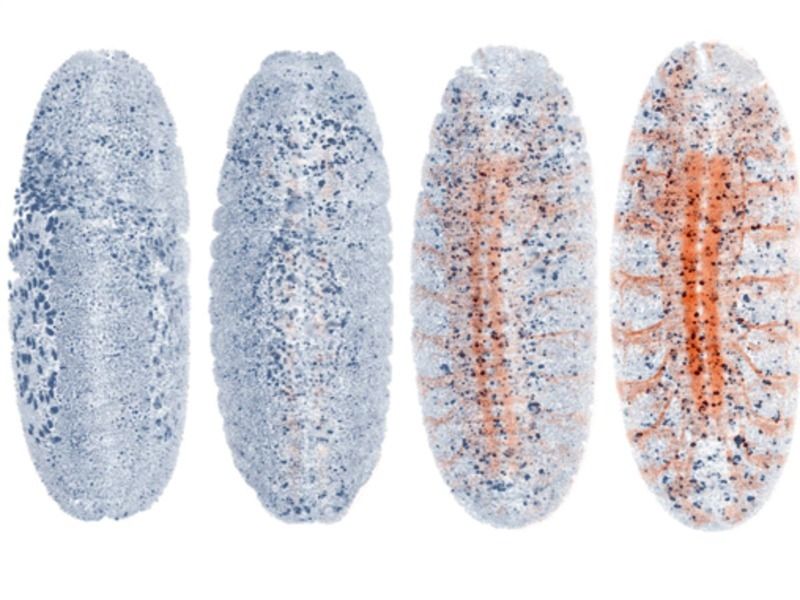The self-driving microscope
Researchers develop a combination of software and hardware for adaptive live imaging of large living organisms
Light-sheet microscopy is one of the most powerful method for imaging the development and function of whole living organisms. However, achieving high-resolution images with these microscopes requires manual adjustments during imaging. Researchers of the Max Planck Institute of Molecular Cell Biology and Genetics in Dresden together with colleagues at Janelia Research Campus (HHMI) have developed a new kind of light-sheet microscope that can ‘drive’ itself automatically by adapting to the challenging and dynamic optical conditions of large living specimens. This new smart microscope combines a novel hardware design and a smart ‘AutoPilot’ system that can analyze images and automatically adjust and optimize the microscope. This framework enables for the first time long-term adaptive imaging of entire developing embryos and improves the resolution of light-sheet microscopes up to five-fold.

20-h imaging of a fruit fly embryo with the nervous system fluorescently labeled. AutoPilot automatically detects the onset of the expression of the marker and optimizes all parameters associated with this color channel in response to the emerging signal.
© MPI of Molecular Cell Biology and Genetics
Light sheet microscopy is a novel microscopy technique developed in the last ten years that is uniquely suited to image large living organisms. In a light-sheet microscope, a laser light sheet illuminates the sample perpendicularly to the observation along a thin plane within the sample. Out-of-focus and scattered light from other planes - which often impair image quality - is largely avoided because only the observed plane is illuminated.
The long-standing goal of microscopy is to achieve ever-sharper images deep inside of living samples. For light-sheet microscopes this requires to perfectly maintain the careful alignments between imaging and light-sheet illumination planes. Mismatches between these planes arise from the optical variability of living tissues across different locations and over time. Tackling this challenge is essential to acquire the high-resolution images necessary to decipher the biology behind organism development and morphogenesis. “So far, researchers had to sit at their microscope and tweak things manually – our system puts an end to this: it is like a self-driving car: it functions autonomously”, says Loïc Royer, first author of the study. This smart autonomous microscope can in real-time analyze and optimize the spatial relationship between light-sheets and detection planes across the specimen volume.
The researchers demonstrated the performance of their smart microscope by imaging the development of zebrafish and fly embryos for more than 20 hours. They also performed adaptive whole-brain functional imaging in larval zebrafish – obtaining sharper images of a whole ‘thinking’ fish brain. In the study they show how their system recovers cellular and sub-cellular resolution in many regions of the sample and how it adapts to changes in the spatial distribution of fluorescent markers. “We have been using our AutoPilot system on several microscopes for more than two years and it makes a big difference in terms of image quality.” says Philipp Keller one of the senior authors with Gene Myers. Making microscopes adaptive and autonomous is important as it will enable the future use of light-sheet microscopy for automated high-throughput drug screens, mutant screens and the construction of anatomical and developmental atlases in various biological model systems.
Most read news
Other news from the department science

Get the life science industry in your inbox
By submitting this form you agree that LUMITOS AG will send you the newsletter(s) selected above by email. Your data will not be passed on to third parties. Your data will be stored and processed in accordance with our data protection regulations. LUMITOS may contact you by email for the purpose of advertising or market and opinion surveys. You can revoke your consent at any time without giving reasons to LUMITOS AG, Ernst-Augustin-Str. 2, 12489 Berlin, Germany or by e-mail at revoke@lumitos.com with effect for the future. In addition, each email contains a link to unsubscribe from the corresponding newsletter.
Most read news
More news from our other portals
Last viewed contents
Otis_R._Bowen
Research_of_Down_syndrome-related_genes
Royan_Institute
Freeman-Sheldon_syndrome
Visual_cortex






















































